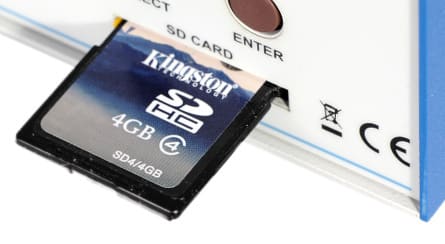Saving measurements on an SD/MMC memory card - the LB-480 and LB-490 recorder

The LB-480/LB-490 recorder features a dedicated memory card storage option — MMC or SD card. The card is used for data archiving; later on, the data may be imported to a data base with the LBX software and obtain their full overview — reports and charts.
Applications
- SD memory card storage temperature and humidity recording
- SD memory card storage recording of data from measuring inputs
- transferring measurement results from a device to a PC in the absence of a connection
Supported card types
The SDXC type cards are not supported.
The card capacity
Taking into account the assumptions for the method of recording on a memory card, cards with a maximum capacity of 4 GB are used. Smaller cards may also be used. Larger cards may be used, but the free space exceeding the maximum capacity will not be used.
Card type
The memory card storage in the recording device is used continuously for recording. This imposes relatively high wear and tear when it comes to recording cycles, which is an entirely different application than those typical for such a card — e.g. in a camera used for taking pictures sporadically.
There are basically 2 card types, when it comes to FLASH technology: SLC and MLC. The SLC type is usually characterised by 10-times greater durability, much better temperature tolerance and due to professional applications, such cards also usually feature ECC errors correction.
All these factors indicate that using cards manufactured in SLC technology are highly recommended. Unfortunately, the majority of popular memory cards in the market are MLC type cards, as the price is a key factor.
The MLC type cards are, at times, labelled “professional” or “industrial”. Due to the rapidly changing market reality, it is difficult to recommend any specific product.
Recording format
The basic assumption for the recording format is that it should be compatible with the Windows system, and this requires that the card is formatted with the FAT type file system.
The FAT file system features many disadvantages; issues with maintaining recording coherence in the case of various malfunctions are particularly problematic. A complete recording of data in the FAT file system usually requires a number of separate recordings in various locations: the right field in a file, file catalogue, allocation tables. Interruption to the whole set of recordings (e.g. due to a malfunction or even a simple power failure) results in file system incoherence that should be repaired, or — in worse cases — re-formatted.
In a device that works continuously, and continuously records data, this issue with the FAT file system usually poses a problem, when there is no user supervision or checks on whether everything is working properly.
In order to prevent file system corruption, there are some assumptions adopted in order to avoid all the possible issues described above.
Specific card format in the LB-480/LB-490
In order to provide reliable recording, the LB-480/LB-490 temperature and other data recorder assumes that the card is prepared in a particular way. The card must be formatted in the LB-480/LB-490 recorder — a card prepared in any other way will not be accepted by the LB-480/LB-490 for recording.
This specific format is, of course, 100% compatible with the FAT file system and the card is fully readable for other various operating systems.
The card format features the creation of only one large file equal to the full card capacity. The file system limits the size of a single file to 4 GB, and that is why only such space may be occupied on a card that is larger than 4 GB.
From the outset, the created file is already at its maximum size. Then, the data recording is conducted within this single file. At the beginning, there are no factual data in the file (the file exists, but it is empty when it comes to usable data). Then, in the course of recording, more data is added to the file although its size remains the same.
The data recording in the file is performed transactionally, which means that failed or unfinished recordings do not change any previously recorded data. All the data are either recorded in their complete form, or they are not recorded at all.
Read-out on a PC
As previously mentioned, the card format is fully compatible with the FAT file system and it may be read on any operating system that supports this format.
Given the fact, that the recording file always features the maximum file size for a given card (up to 4 GB), in order to read data for the LBX software, it is not recommended to copy the file to a PC hard drive; instead, the path to the file stored directly on the memory card in the card reader should be indicated for the LBX software.
In this way, the LBX software will read out only the data that exist in the file, without the need to copy the part of the file that is still not used.


